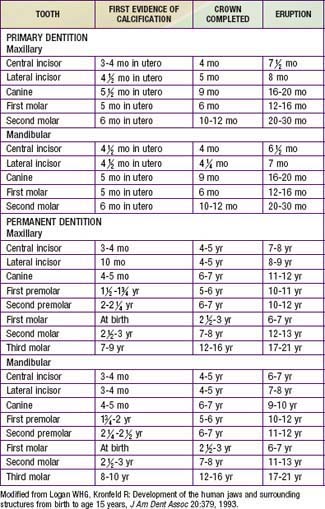Chapter 299 Development and Developmental Anomalies of the Teeth
Initiation
The primary teeth form in dental crypts that arise from a band of epithelial cells incorporated into each developing jaw. By 12 wk of fetal life, each of these epithelial bands (dental laminae) has 5 areas of rapid growth on each side of the maxilla and the mandible, seen as rounded, budlike enlargements. Organization of adjacent mesenchyme takes place in each area of epithelial growth, and the 2 elements together are the beginning of a tooth.
After the formation of these crypts for the 20 primary teeth, another generation of tooth buds forms lingually (toward the tongue), which will develop into the succeeding permanent incisors, canines, and premolars that eventually replace the primary teeth. This process takes place from ∼5 mo of gestation for the central incisors to ~10 mo of age for the 2nd premolars. The permanent 1st, 2nd, and 3rd molars, on the other hand, arise from extension of the dental laminae distal to the 2nd primary molars; buds for these teeth develop at ∼4 mo of gestation, 1 yr of age, and 4-5 yr of age, respectively.
Histodifferentiation-Morphodifferentiation
As the epithelial bud proliferates, the deeper surface invaginates and a mass of mesenchyme becomes partially enclosed. The epithelial cells differentiate into the ameloblasts that lay down an organic matrix that forms enamel; the mesenchyme forms the dentin and dental pulp.
Calcification
After the organic matrix has been laid down, the deposition of the inorganic mineral crystals takes place from several sites of calcification that later coalesce. The characteristics of the inorganic portions of a tooth can be altered by disturbances in formation of the matrix, decreased availability of minerals, or the incorporation of foreign materials. Such disturbances can affect the color, texture, or thickness of the tooth surface. Calcification of primary teeth begins at 3-4 mo in utero and concludes postnatally at ∼12 mo with mineralization of the 2nd primary molars (Table 299-1).
Eruption
At the time of tooth bud formation, each tooth begins a continuous movement toward the oral cavity. The times of eruption of the primary and permanent teeth are listed in Table 299-1.
Anomalies Associated with Tooth Development
Both failures and excesses of tooth initiation are observed. Developmentally missing teeth can result from environmental insult, a genetic defect involving only teeth, or the manifestation of a syndrome. Anodontia, or absence of teeth, occurs when no tooth buds form (ectodermal dysplasia, or familial missing teeth) or when there is a disturbance of a normal site of initiation (the area of a palatal cleft). The teeth that are most commonly absent include the 3rd molars, the maxillary lateral incisors, and the mandibular 2nd premolars.
Stay updated, free articles. Join our Telegram channel

Full access? Get Clinical Tree



